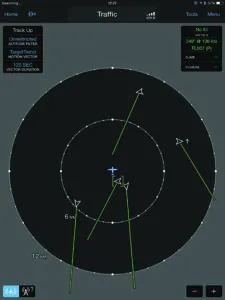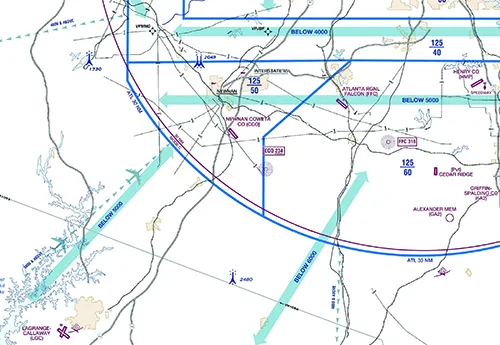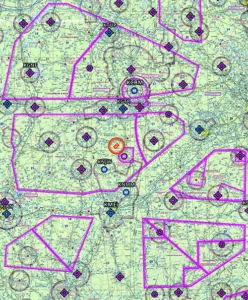If you’re like me, one of the reasons you started flying was to go places. It’s not at all uncommon for the student pilot pounding around the pattern with an instructor to ask for a respite every now and then, perhaps a jaunt to a nearby airport, at the very least for a change of scenery. As experience and instructor confidence grow, that student eventually graduates to flying cross-countries to distant airports, which requires learning a completely new and different set of skills and concerns. That’s part of the training process—acclimating the student to new environments while developing understanding and respect for their differences.
Thanks in part to being a non-wealthy college student and then starting a career, the first handful of years after I earned my private certificate were spent just trying to maintain a three-bangs-and-goes level of currency. But as my economic situation improved with time, so did the desire to use the ticket to go places. It took this still-green private pilot a while to figure out how different the en route environment is and that many of the skills I needed to fly defensively outside the traffic pattern were poorly developed. Of particular concern when in the en route environment is that conflicting traffic—while always something we should search for and be concerned about—isn’t the only in-flight challenge when cruising off into the sunset.
Flight Following
One aspect of my primary training involved a mindset that the only time I needed ATC was when I was using a towered airport. At the time, the general aviation community was chafing over new mandates to use transponders and talk to controllers at larger airports when flying VFR. These mandates manifested themselves as terminal control areas (TCAs, a precursor to Class B airspace) and terminal radar service areas (TRSAs, analogous to Class C airspace). Looking back, expanding ATC services and growing comfortable with their use was inevitable, but I didn’t realize it at the time. Put another way, I’ve evolved from my VFR-only days when I avoided dealing with ATC except when absolutely necessary.
That evolution leads me to conclude that obtaining VFR flight following services is critical to defensive flying in the en route environment. There’s really no excuse: Workload permitting, ATC will provide traffic advisories and urgent weather notifications, plus real-time monitoring of your progress. If you have a problem, you’re already in the system and a mash of the mic button gets you all the assistance ATC can render, like a vector to the nearest airport. Since you’re already plugged into the system, entering and transiting Class B, C or D airspace can be seamless, and you’ll get a heads-up if a restricted area you plan to penetrate suddenly goes hot, or if a TFR pops up in front of you. It’s one of the best aviation deals you’ll find.
Another benefit of VFR flight following is the exposure you get to the ATC system itself. Generally, IFR traffic in the area will be on the same frequency. By merely listening, you’ll pick up invaluable real-time information on weather and traffic concentrations, among other nuggets. And you’ll learn lots about how to use ATC and how to project confidence on the frequency, even when you don’t feel confident. When you add your instrument rating, that exposure will become invaluable—you’ll know better what works and what doesn’t when it comes to getting shortcuts and the best service from ATC. Again, it’s a bargain.
Obtaining and using VFR flight following is beyond this article’s scope. The bottom line, especially when it comes to flying defensively outside the traffic pattern, is that obtaining and using VFR flight following should be one of the standard items in your bag of tricks, unless you can go IFR.
Fuel
But defensive flying isn’t completely about identifying and avoiding traffic. The idea is to defend—inoculate us, perhaps—against the different hazards we may encounter when flying en route. It should be a simple and obvious thing that ensuring we have enough fuel for the flight is a basic defensive-flying move, but it’s apparently complicated and obscure instead, leaving many pilots each year to run out of gas. Of course, then we need to determine what’s “enough.”
I’ve always thought the FAA’s 30-minute reserve fuel requirement for VFR flight to be wildly optimistic. I can see that it’s adequate when we’re considering only my Champ or a Cessna 150, where even full-throttle fuel consumption really isn’t that high. Throw at least one big-bore Continental or Lycoming into the mix, however, along with a go-around and full-power climb back to altitude and 30 minutes at that consumption rate may be more fuel than the Champ can carry.
The point is that when we’re considering the things that can go wrong in the en route environment—weather, airspace deviations, un-forecast headwinds, airport closures—carrying only 30 minutes of reserve fuel simply isn’t in keeping with the kinds of things we’re trying to defend against.
What is a reasonable fuel reserve for en route flying? As with so many things, it depends. To me, though, I want at least an hour of fuel on board when I shut down on the destination’s ramp after a VFR flight. If I’m IFR, I want more, and I’ll seriously consider an en route stop if the weather starts caving or the headwinds are strong. Whatever you do, consider the FAA’s VFR and IFR fuel reserve requirements to be the bare minimum.
With the advent of in-cockpit fuel prices, we can make better-informed choices on where to stop for fuel. Don’t do what I did once several years ago, though. The cheapest gas along my route to Oshkosh that summer was a non-towered airport in Kentucky, I think, and I dutifully filed IFR to that airport. Turns out, it had pretty much the worst weather along my entire route, and I ended up having to shoot an approach to minimums to get in. The FBO staffer remarked that we were the only transient so far that day. I believed him. In hindsight, that’s fairly aggressive, instead of being defensive. I had plenty of gas to get to Oshkosh, but wouldn’t have much for loitering when I got there, hence the en route stop. I should have gone someplace else, where the weather was better, even if I might have spent an extra nickel a gallon.
Choke Points
With or without flight following, there are times and places when the relative lack of traffic in the en route environment no longer applies. I call these choke points—locations where en route traffic is concentrated and your risk of a close encounter is increased.
The classic example of an en route choke point is a navigational aid, whether electronic or visual. In fact, I was trained to really be on my traffic-spotting toes when within, say, five miles of a VOR. That was back in the day when VOR was the primary method of en route navigation, whether IFR or VFR. These days, we may have fewer VORs and everyone pretty much is using GPS to go direct, but we have many more choke points, where traffic of all kinds can become concentrated.
But to me, the airspace underlying tiered Class B airspace can be the most densely populated with potential traffic conflicts. Think about it: You’ve got a hard floor beneath you and soft one above you. Everyone and their mother trying to get around that Bravo wants to do the same thing as you: sneak underneath it without bothering to talk to ATC.
The graphics below reproduce the FAA’s VFR Flyway Planning Chart found on the reverse side of a paper VFR terminal chart. These flyway charts omit most of the topographical information and instead show typical traffic flows near and inside the associated Class B airspace. As shown, traffic in the area can expect turbojet traffic letting down for arrival into Atlanta from the southwest well outside the Bravo and as low as 5000 feet MSL.
FAA’s VFR Flyway Planning Chart
The FAA’s VFR Flyway Planning Chart for the Atlanta Class B airspace is rightly marked “not to be used for navigation,” but it’s an excellent tool to help you identify where some of the choke points may be in that area. Among other things, it also may disabuse you of the idea that heavy jet traffic is only in the the associated Bravo airspace.
If you fly in or near airspace for which such a chart is published, it’s a good idea to study it and learn where you can expect the highest concentrations of traffic. If you’re just passing through and aren’t entering the Bravo, it’s another resource for you to use in planning your route.
Altitude Choices
I generally want to cruise at the highest feasible altitude for the trip length, which often translates into altitudes where it’s not only prudent but required to use supplemental oxygen in an unpressurized airplane. Those of you fortunate enough to be flying something that’s pressurized know that feature affords you even more flexibility. The beauty of climbing into the teens—or higher—is that there’s usually a lot less traffic. The downside is the traffic you do find up there is usually moving a lot faster than you are, sometimes affording less time to identify and react for collision-avoidance purposes. And then there’s the fact that if something happens, and you need to get down in a hurry, it will take a lot more time to reach a suitable airport from 15,000 feet AGL than it does from “only” 5000 feet.
“Feasible” is doing a lot of work here, of course, since what makes sense to me may not resonate with you. Considerations involved with choosing a cruising altitude include aircraft capability, of course, with the aforementioned oxygen availability or pressurization being another, along with performance and weather, among others. Cruising in the teens affords other benefits, too.
One of them is a reduced number of frequency changes. Over populated portions of the U.S., for example, most IFR and participating VFR traffic below, say, 10,000 feet MSL is handled by the local terminal radar approach control, or TRACON. Above whatever altitude is agreed upon between the facilities, the area air route traffic control center, ARTCC, handles that workload. For a cross-country flight of 500 NM, there may be several TRACONs handling lower altitudes while only two or three ARTCCs. That a lot less frequency changes you’ll have to make.
This overview of en route defensive flying merely scrapes some of the surface, since we didn’t get into weather, route selection or other considerations. But if you use flight following, avoid or at least keep your eyes peeled when near choke points, carry enough gas and choose an altitude above the fray, you’ll be fine.

En Route Traffic
Potential traffic conflicts while en route are less predictable than those you might encounter in an airport traffic pattern. That should be obvious because not everyone wants to place their airplane onto or depart from the same strip of pavement, and attempt to fly a traffic pattern as they do it. While it might seem much more random, there’s actually a lot of logic involved in anticipating where potential traffic conflicts might arise in the en route environment.
The sectional chart excerpt showing an eastern portion of the Miami Class B airspace at left tells some of the tale. This shows four general aviation aircraft, the orange dots, scooting up or down the coast at between 350 feet and 800 feet AGL. That one of them, N72AB, apparently is a banner-towing operation helps make the point that choke points where potential traffic conflicts can arise aren’t always associated with navigation fixes.
Special Use Airspace
If you conclude the chart excerpt at right shows Mississippi‘s airspace as one big military operations area, outlined in magenta, you’re not wrong. If the associated flight training operations are in full swing, you may have an IFR detour in your future. When VFR, you might get up close and personal with some military hardware.
This article originally appeared in the August 2020 issue of Aviation Safety magazine.
For more great content like this, subscribe to Aviation Safety!








































Great article! I agree with most of it but would even go beyond. First time I did a REAL cross country on my own I was awakened to all the stuff you don’t learn in PRACTICE cross countries. My instructor told me nothing about tie down fees for overnights, courtesy cars, finding food, ramp fees (don’t park over there with the Learjets and Kingairs), bring a can of oil with you etc. etc. Like other aspects of life, this shouldn’t be learned “in the locker room”. This would be a great subject for a book or a series of articles but alas I’m not flying any more and am not the best author. Bet someone on staff here could do a good job of it.
Yup – my primary training was at a school that had line service and rented “wet”. You called a number if the plane needed fuel and that was rare because the CFI on the last lesson tended to do it. First time solo in my own plane and I pulled up to a self-serve. Now I KNEW you needed to ground the plane. But then I got my first lesson in the many and varied types of self serve each with their own peculiarities. I even discovered that sometimes – if you really did want to ground the plane – you needed to get your toolkit out to repair the snarl the last user of the pump left in the ground reel. (or was it many users ago?)
There is also a real need to give students “relief” by letting them go fly with others at the airport – to a breakfast flyout or whatever. To see the side of GA they never see in the training pattern or practice area. Or even to just let them sit in the passenger seat with a sectional (or EFIS these days) and look outside and let them figure out what they are looking at compared to the depiction on the sectional. A skill that is very hard to acquire while also flying the plane with low hours.
This was a nice read. I experienced all of this during my first few cross countries in the crowded airspaces along the Wash DC – NYC corridor.
You mentioned getting and using Flight Following as a future article, I’m looking forward to that. I use it every time for longer trips, specifically for the ATC contact you mentioned, and getting in and out of Class B airspaces. One question I do have for you, and one I haven’t really gotten a good answer from elsewhere, relates to the use of Flight Following with a filed VFR flight plan. I don’t believe ATC has access to your filed plan, so my thoughts are to file the plan, but if I get Flight Following to then cancel the VFR plan since I will mostly likely not be on it. Thoughts?
Great..just great. In my student days, early 90s, I went thru three CFIs, no… The first two hit a number of hours and returned to Scandinavia to mainline flying..but they all urged me to use all these aids in my cross country flying. Here in SoCal at fringe of LA, plenty of traffic… And at my age of 59, they knew I was not going to ” the bids”, but wanted me ready for flying the Southwest ( I had locations in AZ, NM, and CO to visit) and they said..you need these tools to safely fly your wife..and get home safely.
Just want to salute the CFIs everywhere.